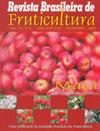Morphological characterization of new banana clones-elites
IF 0.9
4区 农林科学
Q4 HORTICULTURE
引用次数: 0
Abstract
Abstract The characterization of clones is a very important step in genetic certification programs, as it describes and recognizes the plant material at every stage of production, allowing the monitoring of genetic quality, improvement and conservation of the germplasm. The aim of this work was to morphologically characterize two elite banana clones. The experimental design applied was in randomized blocks, with four replications, with six plants per parcel. The treatments consisted of two elite banana clones, Prata Gorutuba R1 and Prata Gorutuba R2 and four commercial cultivars: Prata Gorutuba, Prata Ana, Grande Naine and BRS Princesa. The morphological characterization was carried out in the second production cycle (daughter plant), using 23 qualitative descriptors, visually evaluated, classified according to the instructions for carrying out the distinguishability, homogeneity and stability (DHS) tests of banana cultivars. The elite clones Prata Gorutuba R1 and R2 differed from the cultivars Grande Naine and BRS Princesa regarding the descriptors tapering of the pseudostem, predominant color of the pseudostem, intensity of anthocyanin coloration and color of the underside of the basal sheath. The descriptors made it possible to group elite clones into the Prata group, a group that predominates in crops in Brazil, with characteristics already widely accepted by the market.香蕉新无性系-精英的形态特征
摘要:无性系鉴定是遗传鉴定中非常重要的一步,它可以描述和识别植物生产的每个阶段,从而实现种质资源遗传质量的监测、改良和保护。这项工作的目的是形态学表征两个优秀的香蕉克隆。试验设计采用随机分组,4个重复,每包6株。这些处理包括两个优质香蕉无性系Prata Gorutuba R1和Prata Gorutuba R2和4个商业品种Prata Gorutuba、Prata Ana、Grande Naine和BRS Princesa。形态学鉴定在第二生产周期(子代)进行,使用23个定性描述符,根据香蕉品种的可区分性、同质性和稳定性(DHS)试验说明进行视觉评价和分类。优质无性系Prata Gorutuba R1和R2在假茎的描述物变细、假茎的显性颜色、花青素的着色强度和基部鞘的底面颜色等方面都与大纳因(Grande Naine)和公主(BRS Princesa)不同。这些描述符使得将优质无性克隆归为Prata组成为可能,Prata组在巴西作物中占主导地位,其特征已被市场广泛接受。
本文章由计算机程序翻译,如有差异,请以英文原文为准。
求助全文
约1分钟内获得全文
求助全文
来源期刊
CiteScore
1.50
自引率
20.00%
发文量
34
审稿时长
4-8 weeks
期刊介绍:
The Revista Brasileira de Fruticultura (RBF) publishes technical articles and scientific communications in the area of fruit crops, referring to results of original searches and unpublished papers in Portuguese, Spanish or English, and 1 or 2 reviews per edition, of invited authors.

 求助内容:
求助内容: 应助结果提醒方式:
应助结果提醒方式:


